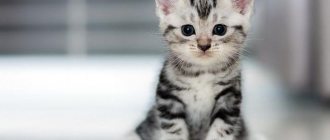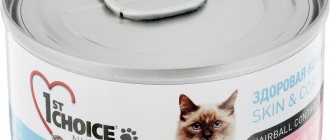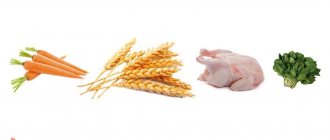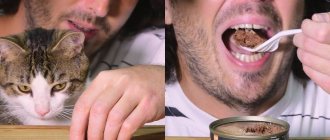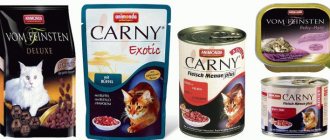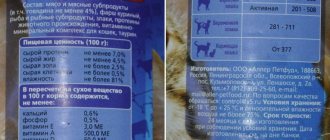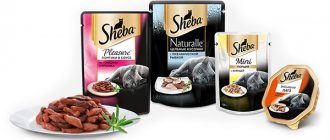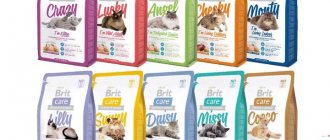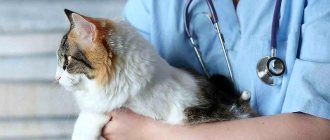We often receive questions from owners, among which one of the most popular is: “We feed our cat a variety of dry food. Is it possible to do this or is it better to choose one brand?” A detailed answer is required here.
First of all, it is worth emphasizing that the creation of dry food was precisely so that it would become the only source of nutrients for domestic animals. The packaging of such products always bears the inscription “complete” or complete feed. Why add something else to a comprehensive diet or alternate between different brands of food? There are several reasons, let's look at them in more detail.
It is not possible to buy the same dry food
This explanation is one of the most common. Owners buy different foods because the range at the nearest pet store is limited and unstable. As a rule, we are not talking about mixing, but about alternating products. What is the danger of such disorderly feeding?
If the food differs significantly in composition, you risk causing a digestive disorder in your cat, which can manifest itself in different ways, and sometimes be completely asymptomatic. When your pet vomits or has diarrhea, it immediately becomes clear that something has gone wrong. But sometimes the problem is not so obvious: mild stool upset and bloating often go unnoticed, but still cause discomfort to the animal and affect the absorption of nutrients, which over time leads to deficiencies of certain elements in the body.
If you are feeding your cat different dry foods, then it is advisable to choose products of equal composition, ideally products from the same line. And the issue of availability of goods today is easily resolved thanks to online trading. For example, Acana and Orijen foods can be ordered from the online stores listed on this page.
Errors and controversial issues
Very often, owners, transferring their own tastes to their pets, try to buy canned food of different types, tastes and brands - either chicken in broth, or pate with fish, or pieces in sauce with venison. This practice is fraught with stomach upset, scratching and other troubles, especially if the animal has sensitive digestion.
The second point is incorrectly calculated feeding rates. With a mixed diet, feed dosages “float”, and owners do little to track them. As a rule, due to wet food, a systematic increase in excess occurs, which after a certain time can lead to obesity, diabetes, problems with the liver and joints.
In addition, you should not be surprised if regular consumption of canned food will eventually cause your pet to completely refuse pellets. Thus, you cannot avoid wasting time and effort on re-accustoming to dry food.
Should I give it together or at different feedings?
This question confuses many owners who are planning to feed their animals both dry and wet food. We must say that experts have not developed a consensus on this matter. Some people believe that it is possible to mix dry and wet food in one bowl, while others strictly recommend observing a break between eating dry and canned food. Practical studies confirming this or that position have not been officially conducted, so it has not yet been possible to dot the i’s.
We would, however, recommend sticking to different feeding times for dried and canned foods. There are two important reasons for this. Firstly, it’s more convenient to determine how much you measure of both, and how much your pet ultimately eats at each meal. Secondly, you will be able to quickly figure out which food the animal’s body did not react too well to, if this suddenly happens.
Let's not forget that wet food is a perishable product, and when it is mixed with dry kibble in the same bowl, both products quickly lose their freshness and taste. If we are talking about cats, which, by their physiology, eat often and little by little, the unused remainder will most likely have to be thrown away when the animals refuse to eat it after an hour or two.
The desire to improve low-quality food at the expense of more expensive food
A popular motive that encourages owners to mix two or more types of ready-made food. In order to save money, cheap food, usually based on cereals, is supplemented with more expensive food with a high meat content. It is assumed that the disadvantages of the first will be compensated by the advantages of the second. Unfortunately, in practice this scheme hardly works.
Firstly, each complete food has its own balanced formula, with a unique composition and ratio of components. Two ingredients that are individually beneficial and recommended for cats may be less digestible in the presence of each other. The consequences are unpredictable - from mild gastrointestinal disorders to serious deficiencies and malfunctions of the body.
Secondly, a diet high in grains itself provokes various diseases in cats: diabetes, urolithiasis (KD), individual food intolerance and other problems.
Finally, there is little point in such a practice. An animal needs more food with a high content of grains to get enough food than a diet based on meat components. We wrote more about this in the article: “How much food does a cat need per month?”
Thus, savings are often illusory. Moreover, when mixed, the beneficial components of expensive food may be less absorbed due to the fact that the “empty” food passes through the gastrointestinal tract at an accelerated rate. As a result, the owner remains even in the red, since he spent in vain on a premium product. Not to mention the high veterinary bills that can come with improper feeding.
And finally...
Perfect Fit™ diets were developed based on the experience of the WALTHAM Veterinary Research Center. Our food is created taking into account the lifestyle of cats in the modern world and takes into account all their needs. We know that a cat's well-being is more than just good nutrition. A healthy diet is a must, but physical activity and play are just as important to your pet's well-being, helping to provide a better standard of living where your cat can enjoy every day from a young age through to old age.
1 Ipsos Pet Grooming Study 2021.
2 For an adult cat with an average weight of 4 kg. WALTHAM® Science.
Different foods are used to provide variety for the cat.
There's really no need for this. Cats are attracted to the content of animal protein and fat in food, and not at all by the novelty. In addition, good dry food already has enough variety. For example, the Acana Grasslands Cat diet contains more than 40 ingredients, including:
- free-range duck and turkey;
- northern pike;
- Alberta lamb;
- whole farm eggs;
- butternut squash;
- fresh forest berries.
Such variety is not always found on the human table! And cats, for the most part, are conservatistic and can be content with the same food for years. But, as with everything, there are exceptions.
If you are “lucky enough” to become the owner of a tailed gourmet who gets bored with his usual food from time to time, you should not radically change his diet every time: it is wiser to pay attention to other flavors from the same line. It is also worth considering that refusal of dry food is not always explained by banal whims. Perhaps your cat's appetite has decreased due to health problems. In this case, alternating feed is not only useless, but can aggravate the problem.
How long does food last in a bowl?
When choosing mixed food, you need to remember that dry and wet food have different shelf life in the bowl. Any food, when exposed to air, is oxidized due to the fats contained in its composition. Wet food, due to its high liquid content, spoils much faster. It may dry out or begin to sour, especially in the warm season, if it is exposed to sunlight. If the cat has not finished the wet food, you need to remove it from the bowl after a couple of hours. An open package of wet food can be stored in the refrigerator only in a hermetically sealed container for 24 hours.
Dry food has a much longer shelf life due to the minimal amount of moisture. The expiration date indicated on the packaging is only relevant for food stored in a hermetically sealed bag, at normal air humidity, without access to light. Dry food tends to spoil in a bowl. Storage time depends on the temperature and humidity in the room, but on average it is a day.
Gradually transitioning a cat from one brand of food to another
This is the only situation when feeding a cat different foods is really justified. Smooth translation helps avoid stress, fluctuations in appetite and digestive problems. It is no coincidence that on every package of ready-made food for cats there is a recommendation to introduce it gradually.
On the first day, 20-25% of new food is added to the old food. Then the share of the latter is increased daily until it reaches 100%. Normally, this transition takes 5-10 days and is painless for the cat. And if the new food contains more meat than the old one, she will only welcome the “reforms”.
What does a cat eat
A cat is an animal that receives all the nutrients in nature from one food source. Depending on their habitat, wild cats mainly catch small rodents, birds and sometimes have the opportunity to catch fish. They do not decorate their lunch with a scattering of steamed vegetables and do not fill the meat with a tasty side dish. Nature has provided another chain: potential prey consumes cereals, fruits and vegetables, and then the cat receives a ready-made stuffed dish.
Domestic cats are not much different from wild cats in terms of nutrition. But selection and the emphasis on breeding beautiful individuals have made them vulnerable and capricious in matters of food. A rare cat can be persuaded to eat a balanced porridge of meat, cereals and vegetables, strictly observing the boundaries of the norm. As a rule, taste preferences take over and some of what is offered is eaten, which makes such food not particularly healthy.
Summing up
If we feed a cat with different dry foods, we must clearly understand why we are doing this and what we are risking. In most cases, this practice has no rational basis and harms the animals in the long run. The exception is mixing feed as a temporary measure at the stage of accustoming to a new brand.
Feeding products of the same line, but with different tastes, is acceptable if it is well tolerated by the cat. But there is no particular need for this, since good dry food already provides a sufficient variety of ingredients.
How to feed
When choosing cat food - dry or wet - you should be guided by the composition. Wet food for cats, the best in composition, should contain primarily meat: the more of it, the better the quality of the food and the more effective it will be for the health of the pet.
Proper nutrition is the key to your pet’s health
Among the elements of natural products you need to add:
- vegetables. It is a valuable source of vitamins and microelements, as well as fiber. They support digestion and increase the nutritional value of food;
- eggs. In some cat foods, eggs are an additional source of protein. In addition to this, they also contain vitamin A, D, iron and polyunsaturated fatty acids;
- taurine is an amino acid found in meat that is essential for keeping your cat healthy. Promotes the proper functioning of the heart and digestive system. In addition, it plays an important role in building immunity and the functioning of the animal’s nervous system;
- vitamins, minerals, trace elements have a beneficial effect on the condition of the cat’s skin, coat and general well-being.
When planning your cat's or kitten's diet, it is important to consider that a good wet food should not contain cereal, sugar, preservatives or artificial colors and flavors. The simple composition and many useful nutrients will allow the cat to live a long time and not get sick.
We often receive questions from owners, among which one of the most popular is: “We feed our cat a variety of dry food. Is it possible to do this or is it better to choose one brand?” A detailed answer is required here.
First of all, it is worth emphasizing that the creation of dry food was precisely so that it would become the only source of nutrients for domestic animals. The packaging of such products always bears the inscription “complete” or complete feed. Why add something else to a comprehensive diet or alternate between different brands of food? There are several reasons, let's look at them in more detail.
